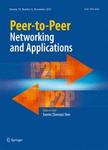版权所有:内蒙古大学图书馆 技术提供:维普资讯• 智图
内蒙古自治区呼和浩特市赛罕区大学西街235号 邮编: 010021

作者机构:Wuhan Univ Technol Sch Comp Sci & Technol Wuhan 430063 Peoples R China
出 版 物:《PEER-TO-PEER NETWORKING AND APPLICATIONS》 (P2P网络与应用)
年 卷 期:2022年第15卷第6期
页 面:2572-2588页
核心收录:
学科分类:0810[工学-信息与通信工程] 08[工学] 0812[工学-计算机科学与技术(可授工学、理学学位)]
主 题:WSNs Clustering epsilon-greedy algorithm Scalable K-means plus Cluster head selection Multi-armed bandit
摘 要:Enhancing energy efficiency and extending the network lifetime are major concerns in the field of wireless sensor networks (WSNs). Clustering helps improving the energy efficiency and extends the network lifetime. In each cluster, a cluster head (CH) is chosen to collect data from its cluster members. However, the cluster head selection process is a vital task as it influences the network lifetime and the data delivery in the network. In this paper, the greedy energy efficient clustering scheme (GEECS) is proposed as a routing protocol based clustering. The proposed scheme treats the CH selection process as a multi-armed bandit problem. Cluster heads are selected using an improved epsilon-greedy algorithm that balances the CH selection rate and increases the network s efficiency. The epsilon-greedy algorithm is combined with the scalable K-means++ algorithm to perform the clustering process. The performance of GEECS is evaluated in terms of packet delivery ratio, number of dead nodes, network lifetime and average cluster head energy per round with respect to the network densities. The simulation results reveal that the GEECS protocol boosts the data delivery rate to the base station, reduces the CH energy dissipation and prolongs the network lifetime compared to other routing protocols. It is notable that for a network of 100 nodes, GEECS increases the network lifetime to 3155 seconds whereas the LEACH and ICFP protocols exhibit an increase of 2250 and 2738 seconds respectively.